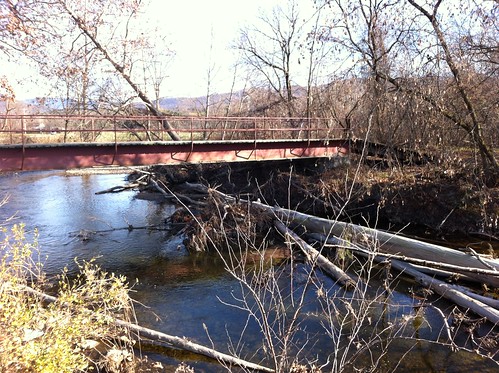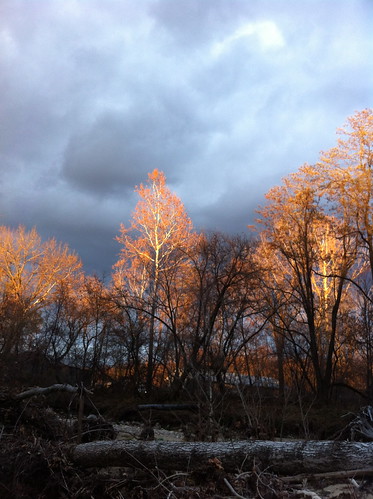I spent a lot of time working on a new project today, and while it isn't directly related to watershed issues, it is related to technology and natural science so I thought I'd mention it here.
I've posted before about iNaturalist, a website and smartphone app that allows people to upload sightings of different living things found in nature, along with photos and location (located by GPS in the case of smartphones). There are a lot of neat potential applications for this program, and I decided to set up a project to help gather data on the organisms living around Middlebury, Vermont; especially land managed by the Middlebury Area Land Trust and/or along the Trail Around Middlebury.
This project allows anyone who downloads the iNaturalist app or registers for the website to upload sightings found in the area. I haven't gotten anyone else involved in this project yet, but I've been doing informal surveys of the vegetation when on solo explores, and have gathered quite a bit of data. You can see what I've found so far by visiting the project website here. While you can't view all the data at once, you can view up to 200 occurrences at once at this link, or navigate to a particular location and refresh to get data on a more local level. Yet, this data is only the tip of the iceberg compared to what is possible using this program. If I can get a few students at Middlebury College or a few of my friends into using this program, we can gather a nearly unlimited amount of data - and with the photo and GPS capability with smartphones, even people who aren't sure of IDs can participate.
One of the funnest parts of this project is that it is possible to create range maps of different species in the area (and throughout the continent if enough people participate!) For example, you can see locations of white pine here (this is a very common species - it's really everywhere - but that means I've documented it many times)... you can see the distribution of white oak (a more restricted species in Vermont) here, and you can look for occurrences of invasive Glossy Buckthorn here (though I have also mapped some on What's Invasive and may make a new 'park' for this area also).
I've also included a Google map below. Note that it is a work in progress - for some reason it is not displaying the occurrences in Battell Woods and I haven't yet figured out why.
View iNaturalist MALT Project in a larger map
Tuesday, November 29, 2011
Sunday, November 27, 2011
A Few Cold Days in a Warm November on the Middlebury River
This November has been a warmer than average one so far in Vermont. The temperature has been above 50 on quite a few days, and many overnight lows have been above freezing. The warm weather wasn't consistent throughout the month, though. Earlier this week we had a cold snap - with temperatures in the mid teens - followed by several inches of wet snow.


Monday, November 21, 2011
A Cold Autumn Visit to the Lower Middlebury River
This November has been an unusually mild one in Vermont so far, but today was an exception. Despite clear skies, the temperature never made it out of the 30s (and now that the sun has set, it is dropping fast). I decided to take a visit to the lower Middlebury River on my way in to town today, because I'd heard news that the City (make that town) of Middlebury was planning to remove some logs from this section from the river, and as I mentioned in the past, this is not always a good idea.

Click below for what I found.

Click below for what I found.
Thursday, November 17, 2011
From Mammatus to Graupel: This November's Wandering Vermont Weather
After a soaking wet and seasonably cold October with a few frosts and some light snow, the onset of November brought an odd weather change to Vermont. The weather dried out, the sun came out, and warmer than average conditions spread over the state.
Above: sun lights up bare deciduous trees along the Middlebury River as it peeks through a gap in the clouds low on the western horizon. You can't see the river from this photo, but the water level is the lowest it has been since before Irene.
Monday, November 14, 2011
Over The River: Can Waterway-Themed Demonstration Art be Harmful?
If you drive north from Los Angeles on Highway 5, you drive through a remarkable pass. After meandering upward past the Santa Clara River and hillsides of chaparral, you enter a wide valley, a 'triple-point' of sorts where the Mojave Desert, the chaparral-covered coastal mountains, and the foothills around the Central Valley all come together. After cresting the Tejon pass at just over 4000 feet of elevation, you plunge into an extremely steep and narrow canyon known as 'The Grapevine' - both because wild grape vines carpet the canyon walls, and because the road itself twists up the canyon like a giant vine. Approaching the area from the north at night, from the flat Central Valley, the row of taillights ahead appears to ascend, in a wide bend, straight into the sky.
A lot of people funnel through this pass every year, and the passage isn't easy. The wide Central Valley to the north creates a giant funnel, channeling not only travelers, but also north winds, straight into the pass. Winds near hurricane force are not uncommon in the winter. Clouds often form as the air rises over the pass, creating dense fog. Worst of all, because the pass captures winds and moisture from the colder north, blizzards often rage on the north side of the pass, even when Los Angeles, 50 miles to the south, is sunny and warm. Meanwhile, in the summer, dry heat from the Mojave Desert and Central Valley build in, leading to temperatures well over 100 degrees, and dozens of overheating cars on any summer day. Because of the unique climate, blue oaks and buckeye trees normally found further north grow on the north side of the pass, while a few miles to the south Joshua trees are clumped in the gullies. It is a place of convergence, but not a gentle place. Even today, passing through The Grapevine can be treacherous, and the pass is known for its road closures and chain-reaction accidents.
The pass is a prominent and important place, and in 1991, two artists - Christo and Jeanne-Claude - decided to fill the pass with giant umbrellas as part of a giant art exhibit. The effect was visually fascinating, but I can't help but speculate that if the artists thought this was a good idea, they had never tried to drive through this pass during a winter storm. Sure enough, by late October a windstorm swept into the area. One of the umbrellas was ripped from the ground and tossed at several people looking at the art exhibit... and a woman was crushed and killed by the umbrella.
Christo is now planning to stretch 7 miles of fabric over the Arkansas River in Colorado.

(above - approaching the Tejon Pass from the south. Clouds banked up against the mountains in winter sometimes warn of a localized blizzard just around the corner)
A lot of people funnel through this pass every year, and the passage isn't easy. The wide Central Valley to the north creates a giant funnel, channeling not only travelers, but also north winds, straight into the pass. Winds near hurricane force are not uncommon in the winter. Clouds often form as the air rises over the pass, creating dense fog. Worst of all, because the pass captures winds and moisture from the colder north, blizzards often rage on the north side of the pass, even when Los Angeles, 50 miles to the south, is sunny and warm. Meanwhile, in the summer, dry heat from the Mojave Desert and Central Valley build in, leading to temperatures well over 100 degrees, and dozens of overheating cars on any summer day. Because of the unique climate, blue oaks and buckeye trees normally found further north grow on the north side of the pass, while a few miles to the south Joshua trees are clumped in the gullies. It is a place of convergence, but not a gentle place. Even today, passing through The Grapevine can be treacherous, and the pass is known for its road closures and chain-reaction accidents.
The pass is a prominent and important place, and in 1991, two artists - Christo and Jeanne-Claude - decided to fill the pass with giant umbrellas as part of a giant art exhibit. The effect was visually fascinating, but I can't help but speculate that if the artists thought this was a good idea, they had never tried to drive through this pass during a winter storm. Sure enough, by late October a windstorm swept into the area. One of the umbrellas was ripped from the ground and tossed at several people looking at the art exhibit... and a woman was crushed and killed by the umbrella.
Christo is now planning to stretch 7 miles of fabric over the Arkansas River in Colorado.

(above - approaching the Tejon Pass from the south. Clouds banked up against the mountains in winter sometimes warn of a localized blizzard just around the corner)
Friday, November 11, 2011
It's Time To Wear Orange! (Deer Hunting and Slow Water)
In many parts of the country, different seasons brings different fashion styles. While I was never very good at figuring out how these work in the city, there is one 'fashion season' in rural parts of the country that is very important, if a bit silly looking.
That's right - it's that time of year where most people outside in Vermont are going to start wearing clothes that are brighter orange than the few maple leaves still clinging to the trees. Rifle season for deer hunting starts tomorrow. Most people heading out into the woods wear a bright orange hat and/or vest, so they aren't accidentally mistaken for a deer. If you're heading out for the next few weeks, you should wear a silly orange hat, too. The last day of rifle season in Vermont is November 27th. Muzzleloader season in Vermont is December 3 - 11. Because these guns have a much shorter range than rifles, mistaken identity issues are less likely, but it's still a good idea to wear orange just in case.
Each state has a somewhat different hunting season, so check with your local fish and wildlife department for more info, if you don't already know.

See below for more thoughts on deer hunting and watershed health.
That's right - it's that time of year where most people outside in Vermont are going to start wearing clothes that are brighter orange than the few maple leaves still clinging to the trees. Rifle season for deer hunting starts tomorrow. Most people heading out into the woods wear a bright orange hat and/or vest, so they aren't accidentally mistaken for a deer. If you're heading out for the next few weeks, you should wear a silly orange hat, too. The last day of rifle season in Vermont is November 27th. Muzzleloader season in Vermont is December 3 - 11. Because these guns have a much shorter range than rifles, mistaken identity issues are less likely, but it's still a good idea to wear orange just in case.
Each state has a somewhat different hunting season, so check with your local fish and wildlife department for more info, if you don't already know.

See below for more thoughts on deer hunting and watershed health.
Wednesday, November 9, 2011
Vermont Updates: Middlebury River Management Planning Task Force; Lake Champlain Meetings
At last night's Town of Middlebury Select Board meeting (which I did not attend this time), plans were laid out to create a task force to deal with river and flooding issues in East Middlebury. From the text of the Selectboard Meeting Highlights:
Middlebury River Management Planning Task Force to be Formed. Following the model of the successful river management planning effort in Ripton, the Board endorsed forming a Task Force to develop a plan for on-going management of the Middlebury River as it flows through East Middlebury.
The specialized, focused group could include representatives from the Agency of Natural Resources, the Planning Commission, the Addison County Regional Planning Commission and a river scientist in an effort led by the Town Manager, with technical experts, including engineers with river science experience and hydrologists, retained as needed. The Board emphasized the need to engage residents of East Middlebury in the process by keeping them informed of the group's efforts and soliciting input during the process.
The river management plan is one component of a Hazard Mitigation Plan. The mitigation plan is a pre-requisite for Federal Emergency Management Hazard Mitigation funding, which is the leading source of funding to implement measures to reduce flood hazards.
Town Manager Bill Finger will meet with East Middlebury resident and river scientist Amy Sheldon to develop a strategy for moving ahead with the Task Force and seeking funding for the planning initiative. Pending negotiation of a scope of work, Amy will be retained on a professional basis to serve as the project manager for the effort.
I hope to be involved, at least as a resident of East Middlebury... and also plan to post updates on this blog, which hopefully will provide a balanced, layperson-focused view on what is happening along the river. In general, I think this is excellent news, and I hope this ends up as an entire-watershed effort and includes working with people in Ripton upstream. It's great that Amy Sheldon is involved as she is both a resident and a great river scientist...
The rest of the highlights from the meeting should be posted here soon.
In other Vermont water news, the Poultney Mettowee Natural Resources Conservation District will be holding public meetings about Lake Champlain on November 17th to discuss issues with phosphorous pollution in the lake, and EPA requirements (apparently they have rejected Vermont's current plan). For more info, see here.
Monday, November 7, 2011
Downed Trees in the River: Burden or Benefit?
When Irene came raging through Vermont, a lot of trees met their demise. Some of them were done in by wind, which was fairly strong in some places, but many more were sucked into raging rivers and tossed into matchstick-like piles on sandbars.

Scenes like the one above are now common in Vermont, and are particularly common along the Middlebury River near where I live. Some are glad to see the logs in the river - they can provide habitat for various animals, including trout and the species they eat. Others are concerned that the logs in the river could cause future problems - causing ice jams or collecting under bridges and causing washouts.
So, who's 'right'?

Scenes like the one above are now common in Vermont, and are particularly common along the Middlebury River near where I live. Some are glad to see the logs in the river - they can provide habitat for various animals, including trout and the species they eat. Others are concerned that the logs in the river could cause future problems - causing ice jams or collecting under bridges and causing washouts.
So, who's 'right'?
Thursday, November 3, 2011
Stories Told by the First Snow
Last weekend East Middlebury picked up its first snow - about an inch, but a few miles north it was a dusting and to the south an unseasonable nor'easter raged. We happened to be just on the edge of the storm.
The light early snow settled on the town and the woods, providing a temporary preview of winter months to come. In a few hours, most of the snow had melted. Between the storm's end and the emergence of the sun, however, the snow sat in place for a couple of hours, slowly melting and dripping down from the trees. At this time, the early season snow told me a lot about how the earth holds the summer's heat long after it is gone from the air.

The light early snow settled on the town and the woods, providing a temporary preview of winter months to come. In a few hours, most of the snow had melted. Between the storm's end and the emergence of the sun, however, the snow sat in place for a couple of hours, slowly melting and dripping down from the trees. At this time, the early season snow told me a lot about how the earth holds the summer's heat long after it is gone from the air.

Subscribe to:
Posts (Atom)

